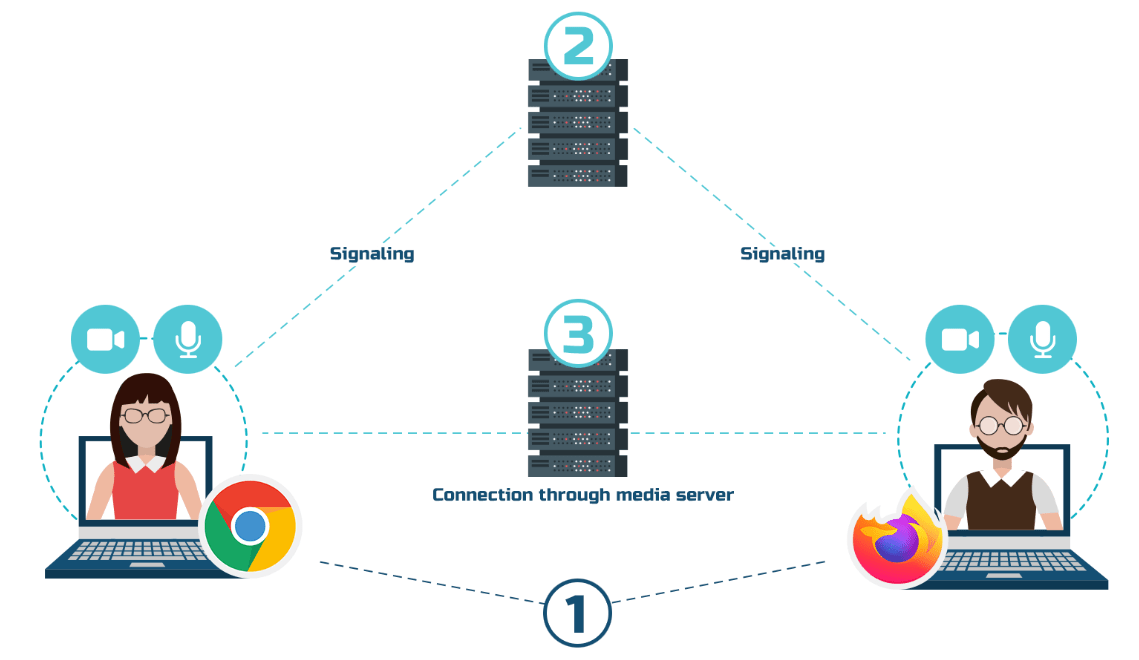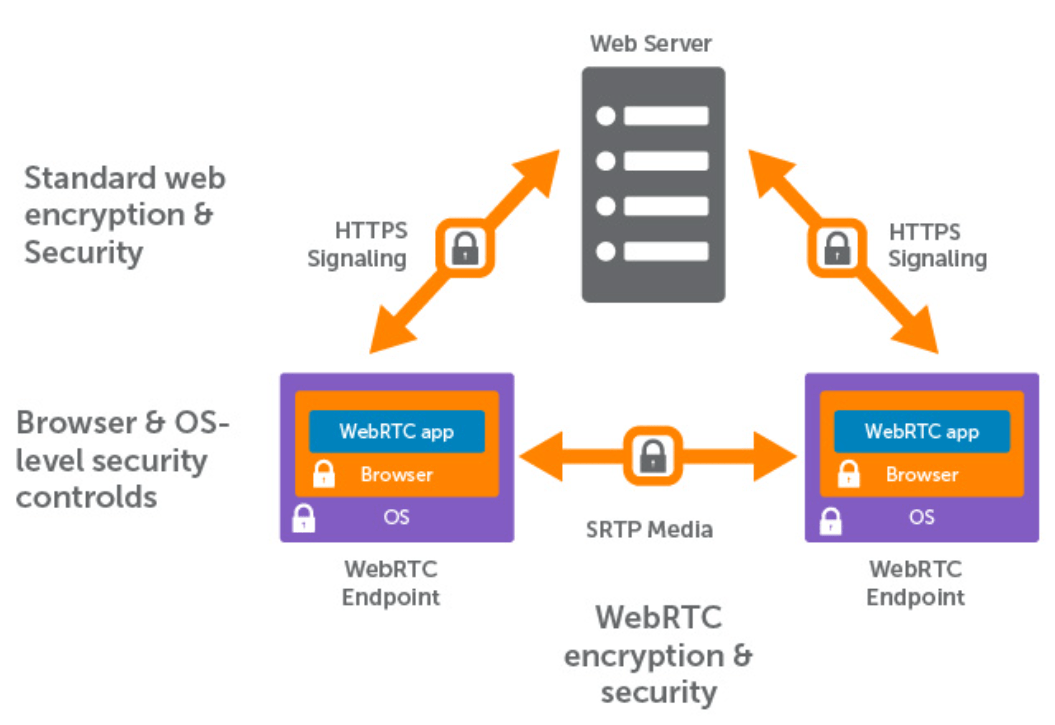In the fast-paced world of adult live streaming, a big question looms: Which protocol should you choose, WebRTC or RTMP? As you weigh your options, you might wonder if the newer WebRTC, with its quick connections, can really compete with RTMP’s proven reliability. Can WebRTC deliver the low latency and smooth interactions that your viewers crave, or does RTMP still reign supreme with its sturdy framework?
In this blog, we’ll dive into the strengths and weaknesses of both protocols, helping you figure out which one aligns best with your webcam business i.e, streaming needs and audience engagement goals. Let’s find out!
What is WebRTC & RTMP?

WebRTC (Web Real-Time Communication) is a modern, browser-based protocol that enables real-time audio, video, and data sharing directly between users without needing plugins, making it ideal for low-latency, interactive experiences. It’s commonly used in video calls and live streaming where instant interaction is key.

RTMP (Real-Time Messaging Protocol), created by Adobe, has long been the standard for streaming, known for its stability and high-quality transmission. Though RTMP requires a server, it reliably delivers continuous streams, making it ideal for high-resolution content where latency isn’t a primary concern.
Why Choosing the Right Protocol Matters in Adult Streaming?
In adult live streaming, choosing the right protocol isn’t just a technical decision – it’s essential for user experience and business success. Each protocol brings unique benefits and challenges, and selecting the right one can directly impact user engagement, privacy, and overall stream quality.
The Importance of User Engagement and Low Latency
User engagement is the lifeblood of live streaming, especially in the adult industry, where audience connection is key. Low latency (or real-time streaming) enables instant interactions, creating an immersive experience that keeps viewers engaged.
The faster users can see responses to their messages or actions, the more personal and engaging the experience feels. High latency can lead to frustrating lags, reducing viewer satisfaction and, ultimately, revenue.
Pro Tip: Before choosing your streaming options, take time to read these key articles to understand the costs and legal aspects involved:
This will ensure you’re fully prepared for success!
Challenges Specific to Adult Streaming
Adult streaming presents unique challenges that make protocol choice even more important:
- Privacy Concerns – The adult industry requires strict privacy measures to protect both streamers and viewers. Data encryption and secure connections are crucial, especially when sensitive information is involved.
- Bandwidth Demands – Many users may access streams on mobile devices or in areas with limited bandwidth. The chosen protocol should be efficient in delivering high-quality content without excessive buffering or interruptions.
- Stability and Quality – Adult streaming services need high stability and consistent quality, as interruptions or buffering can result in a loss of users and credibility.
Latency: WebRTC’s Ultra-Low Latency vs. RTMP’s Slight Delay
Latency refers to the time delay between capturing a video frame and when it is displayed on the viewer’s screen. This delay can be measured in milliseconds (ms) and is critical for live streaming because it affects how “live” the experience feels to the audience.
In adult streaming, where interactivity is often key such as during live chats or Q&A sessions, lower latency can lead to a more engaging and satisfying viewer experience. High latency can result in frustrating delays that diminish user participation and enjoyment.
WebRTC’s Real-Time Latency
WebRTC is known for its ultra-low latency, often under 500 milliseconds, making it an ideal choice for interactive live streaming. WebRTC uses peer-to-peer connections directly between browsers, bypassing the need for a central server for video routing, which significantly reduces transmission time.
Additionally, WebRTC operates on UDP (User Datagram Protocol), a network protocol that prioritizes speed over error correction, further minimizing delays. This setup enables streamers and viewers to experience near-instant communication, essential for creating immersive, real-time interactions that keep audiences engaged.
RTMP’s Slight Delay
In contrast, RTMP is known for its stable, high-quality video transmission but typically has a latency of 1–3 seconds. RTMP operates through a central server, which improves stability but adds processing and routing time, resulting in this slight delay.
While 1–3 seconds may not seem like much, it can make a noticeable difference in interactive adult streaming, where real-time reactions are crucial. RTMP uses TCP (Transmission Control Protocol), prioritizing reliable data delivery over speed, which can sometimes slow down live interactions.
In short, WebRTC excels in interactive settings, while RTMP is a reliable choice for traditional streaming with slight latency tolerances. The best choice depends on the streaming experience you aim to create for your audience.
Scalability & Stability
WebRTC is a peer-to-peer (P2P) protocol, which excels in creating real-time, low-latency connections between a few participants. However, its P2P nature makes it challenging to scale for large audiences. Each viewer or participant requires a separate connection to the broadcaster, which quickly consumes bandwidth and processing power on both ends.
RTMP, on the other hand, is designed to handle larger audiences more effectively. As a server-based protocol, it streams content from a central server, sending the same data to multiple viewers simultaneously.
This “broadcast” model is better suited for scalability, as it doesn’t require individual connections to each viewer. RTMP servers support many viewers without a direct increase in bandwidth or resource demands on the broadcaster’s side, making it more stable for larger audiences and more suitable in high-bandwidth environments.
In short, WebRTC works best for smaller, interactive sessions, while RTMP is more scalable and reliable for larger broadcasts. The choice depends on whether your focus is on direct viewer interaction or reaching a broad audience with a stable, high-quality stream.
Interactivity: The Role of Two-Way Communication
When it comes to interactive adult live streaming, two-way communication is key to creating an engaging, personal experience for viewers.
WebRTC shines in this area, as it’s specifically built for real-time, two-way communication. Using a P2P framework, WebRTC enables instant audio, video, and data sharing between the broadcaster and the audience, making interactions almost seamless.
Viewers can send messages, see immediate responses, and feel more involved, fostering a level of intimacy that’s crucial in adult content. This makes WebRTC perfect for interactive shows, private sessions, and any content where live, personal engagement is a priority.
RTMP, in contrast, is built primarily for one-way streaming. Its central-server model is excellent for delivering stable, high-quality broadcasts to large audiences but lacks the interactivity WebRTC offers.
While RTMP can support some chat functionality, it doesn’t allow real-time, two-way audio or video interaction with the same immediacy. This makes it a solid choice for platforms focused on high-quality video delivery where interaction isn’t the main focus.
Bandwidth Efficiency
Bandwidth efficiency is a critical consideration in adult live streaming because it can significantly affect user experience.
WebRTC: Higher Bandwidth Requirements
WebRTC encodes video on the sending side and transmits it as a continuous stream. While this allows for low latency it can lead to increased bandwidth consumption.
- Real-Time Encoding
WebRTC typically requires a minimum of 500 kbps for decent video quality, with higher resolutions demanding even more bandwidth.
For example, streaming at 720p might require around 1.5 Mbps, while 1080p can push that requirement to 3 Mbps or more. This increased demand can strain users with limited bandwidth, leading to potential buffering and quality degradation during peak usage times.
- Adaptive Bitrate Control
WebRTC employs adaptive bitrate streaming, which adjusts the quality of the video in real-time based on network conditions.
While this feature helps maintain a smooth experience, it can also lead to higher average bandwidth usage during optimal conditions when the system prioritizes higher-quality streams
- Peer-to-Peer Connections
The architecture of WebRTC means that each user connects directly to others, which can exponentially increase the total bandwidth needed as more participants join a session.
This scalability challenge can make it less suitable for larger audiences without significant infrastructure investment.
RTMP: Efficiency in Video Quality at Lower Bandwidths
In contrast, RTMP is known for its efficiency in delivering high-quality streams at relatively lower bandwidths.
- Lower Bitrate Requirements
RTMP can maintain good video quality at lower bitrates compared to WebRTC.
For instance, streaming in standard definition (SD) might require only 640 kbps, while high definition (HD) streaming can range from 1,500 kbps to 4,000 kbps depending on the resolution and frame rate. This efficiency makes RTMP particularly suitable for scenarios where bandwidth is constrained.
- Enhanced RTMP with Modern Codecs
With advancements like Enhanced RTMP supporting codecs such as HEVC (H.265), broadcasters can achieve superior video quality at lower bitrates than traditional H.264 encoding.
For example, using HEVC can reduce streaming bitrate requirements from 2,500 kbps to around 2,000 kbps without sacrificing clarity, making it ideal for mobile streaming or large-scale broadcasts where bandwidth costs are a concern.
Privacy & Security
Privacy and security are crucial in adult live streaming, where sensitive content requires robust protection for both performers and viewers.
WebRTC: Built-In Encryption and Security Protocols
WebRTC has a distinct advantage in security due to its built-in encryption protocols. Every WebRTC connection is encrypted by default using DTLS (Datagram Transport Layer Security) for data integrity and SRTP (Secure Real-Time Protocol) for secure audio and video.

This ensures end-to-end encryption, making WebRTC a highly secure option for streaming. All data transferred, including video, audio, and chat messages, is encrypted in real-time, reducing the risk of data breaches or unauthorized access. This built-in security makes WebRTC a good choice for privacy-conscious platforms.
RTMP: Some Security Gaps and Workarounds
RTMP on the other hand itself does not provide encryption by default. This means that without additional measures, data transmitted over RTMP can be vulnerable to interception.
To enhance security, RTMP can be used over SSL/TLS, which encrypts the data in transit between the client and server. However, this setup requires careful configuration to ensure that all streams are adequately secured
Since RTMP often relies on plugins or custom players for browser compatibility, outdated software can introduce vulnerabilities. Regular updates and maintenance are necessary to mitigate these risks.
Additionally, while RTMP supports token-based authentication and IP address restrictions for access control, these measures are not foolproof without proper implementation
Browser & Device Compatibility
WebRTC: Native Support Across Browsers and Devices
WebRTC is designed for real-time communication and is natively supported by all major modern browsers, including Google Chrome (since version 28), Mozilla Firefox (since version 22), Microsoft Edge (from version 12 onwards), and Apple Safari (starting from version 11). This compatibility eliminates the need for plugins or additional software installations, simplifying the user experience.
Device Compatibility
WebRTC is also compatible with mobile devices, allowing users to connect via smartphones and tablets. With iOS 14.3 and later versions, users can use WebRTC-compliant browsers like Chrome and Firefox on their iPhones & iPads for audio and video calls. This flexibility enhances accessibility for users who prefer mobile devices over desktops.
However, despite its broad compatibility, some performance variability may occur based on the device’s hardware capabilities and network conditions. For instance, older devices may struggle with high-resolution video streams or complex interactions due to limited processing power.
RTMP: Established Presence with Better Support for Legacy Systems
RTMP has been a staple in the streaming industry for many years and is particularly effective for one-way broadcasts. However, its compatibility landscape differs from that of WebRTC.
RTMP does not natively support modern web browsers without additional plugins or configurations. Historically, it required Flash Player for playback, which limited its usability as Flash has been phased out. However, many streaming platforms still use RTMP for ingesting streams before converting them into formats compatible with HTML5 players.
Device Compatibility
RTMP’s legacy support means it can work well with older systems that may not support newer technologies like WebRTC. Many established streaming services continue to rely on RTMP due to its reliability in delivering high-quality streams over stable connections.
This makes it an excellent choice for environments where legacy systems are prevalent or where users may be accessing content from older devices.
Implementation & Cost Considerations
Ease of Implementation
WebRTC can be powerful for real-time streaming but involves a more complex setup. Since its P2P protocol, WebRTC requires signaling servers to help users find each other and establish connections.
Once the connections are in place, data can be streamed directly between users, which is great for low-latency interactions but adds layers of complexity in setup. Additional components like TURN and STUN servers are often required for handling network obstacles, like firewalls and NATs (Network Address Translators). This complexity typically demands higher technical expertise and greater time investment, often making WebRTC implementation more challenging and costly upfront.
RTMP is far simpler to integrate. It relies on a central server which allows for a straightforward setup. Popular streaming platforms like Wowza, Red5, and Adobe Media Server are well-optimized for RTMP, often offering out-of-the-box integration and support, making it easy for content creators to get started.
This simplicity reduces the initial technical overhead, making RTMP especially appealing for those looking to start streaming quickly without intensive setup.
Cost of Infrastructure
Scaling WebRTC for larger audiences can be expensive. Its reliance on P2P connections requires more bandwidth and specialized infrastructure to handle high-quality, low-latency streams. Expect costs ranging from $500 to $2,000 per month for infrastructure, depending on audience size.
On the other hand, RTMP is more cost-effective, requiring lower bandwidth and server resources. For smaller-scale operations, RTMP may cost as little as $50 to $500 per month, making it a more budget-friendly option for those starting out.
Maintenance and Technical Support
Ongoing maintenance for WebRTC can be resource-intensive as infrastructure scales. Developers must continuously monitor signaling servers and manage connection stability, which may require specialized knowledge.
Conversely, RTMP offers more straightforward maintenance, particularly when using third-party streaming services that handle server management and technical support. This simplicity can reduce operational overhead and allow content creators to focus more on content rather than backend complexities.
Use Case Scenarios: When to Use WebRTC vs. RTMP
Understanding when to use each protocol can help maximize user engagement and ensure a smooth streaming experience. Here’s a detailed look at the scenarios where each protocol excels.
WebRTC: Ideal for Interactive Streaming and Higher Engagement Sessions
WebRTC is designed for real-time communication, making it perfect for scenarios that require high interactivity. Here are some use cases where WebRTC shines:
- Live Video Chats – In adult live streaming, performers can engage directly with viewers through video chats. WebRTC’s low latency ensures that interactions feel immediate, enhancing the overall experience and encouraging viewer participation.
- Interactive Performances – WebRTC allows for real-time feedback and interaction during performances, such as live Q&A sessions or personalized shows. This level of engagement can significantly increase viewer satisfaction and retention.
- Gaming and Multiplayer Experiences – For platforms that integrate gaming elements with adult content, WebRTC’s ability to facilitate peer-to-peer connections allows for seamless multiplayer interactions, enhancing the entertainment value.
- Telemedicine and Counseling – In scenarios where adult content intersects with health or counseling services, WebRTC provides a secure and private way to conduct consultations in real-time, ensuring confidentiality and immediacy.
RTMP: Best for One-to-Many Streaming
RTMP has been a standard in the streaming industry for many years and is particularly effective in scenarios where high-quality broadcasts are essential. Consider using RTMP in the following situations:
- Large-Scale Events – For adult live streaming events that expect a significant number of viewers (like virtual parties or concerts), RTMP’s centralized server model allows for stable broadcasts without overwhelming individual connections. This ensures that all viewers receive a high-quality stream without lag.
- Pre-Recorded Content – If your platform includes pre-recorded adult content or on-demand videos, RTMP is an excellent choice due to its ability to deliver high-quality streams efficiently. It can handle various resolutions and bitrates, making it versatile for different viewing conditions.
- Integration with Streaming Services – Many popular platforms like YouTube, Twitch, and Facebook Live use RTMP for ingesting streams. If your content is intended for distribution on these platforms, RTMP is often the preferred protocol due to its established compatibility.
- Professional Broadcasting – For studios or professional setups requiring reliable streaming with minimal buffering, RTMP provides robust infrastructure support. It integrates well with encoding software and offers features like adaptive bitrate streaming to optimize viewer experience based on their internet speed.
Real-World Examples and Case Studies
Below, we explore real-world examples of adult live streaming platforms using RTMP and WebRTC and the unique benefits each protocol brings to these sites.
Using RTMP for Adult Live Streaming
1. Chaturbate
- Overview – Chaturbate is one of the most popular adult webcam sites, where performers can stream live content directly to viewers. It offers a diverse range of models and interactive features that engage audiences.
- RTMP Support – Chaturbate supports RTMP streaming, which allows for high-quality broadcasts. Performers can easily set up their streams using external encoders like OBS (Open Broadcaster Software) by accessing their RTMP stream key from their account settings.
- Monetization – The platform provides multiple monetization options for performers, including tipping, private shows, and premium memberships, enabling them to earn income based on viewer engagement.
Pro Tip: Curious to learn more about Chaturbate? Be sure to check out these essential reads to get the full scoop before diving in:
- What is Chaturbate? & How Does Chaturbate Work?
- How Much Money Can You Make on Chaturbate?
- 8 Sites Like Chaturbate: Best Alternative Sites
These resources will give you a clear picture of what you’re stepping into!
2. LiveJasmin
- Overview – LiveJasmin is known for its high-quality streams and professional models. It has established itself as a leading adult cam site with a focus on user experience.
- RTMP Support – The platform uses RTMP to deliver smooth streaming experiences, ensuring minimal buffering and high-definition video quality during live broadcasts.
- Monetization – LiveJasmin offers various monetization strategies such as tipping, private shows, and premium memberships, allowing models to maximize their earnings while providing engaging content.
Using WebRTC for Adult Live Streaming
3. CamSoda
- Overview – CamSoda is an innovative adult cam platform that emphasizes interactivity through live events and features like virtual reality.
- WebRTC Support – CamSoda uses WebRTC technology to deliver high-quality broadcasts with minimal latency, allowing for real-time interaction between models and viewers. This low-latency streaming is crucial for providing a seamless interactive experience.
- Monetization – The platform allows performers to earn through tips, private shows, and pay-per-view content.
4. Stripchat
- Overview – Stripchat has quickly gained popularity due to its user-friendly interface and diverse content offerings.
- WebRTC Support – Stripchat leverages WebRTC for real-time, high-performance streaming. This enables an optimal performance for viewers and smoother interaction, especially in private chats and live shows.
- Monetization – Models can earn money through tips, private chats, and fan clubs, providing multiple avenues for revenue generation.
WebRTC vs RTMP: The Final Verdict
In the debate of WebRTC vs. RTMP for adult live streaming, the decision boils down to your specific needs. If real-time interaction and ultra-low latency are crucial, WebRTC shines as the top choice, fostering a more engaging and immersive experience. However, if stability, scalability, and compatibility are priorities for large audiences, RTMP offers a reliable, high-quality stream. Both protocols have their strengths; selecting the right one will ensure you’re delivering the best possible experience for your viewers, enhancing satisfaction and engagement on your platform.
FAQs About WebRTC & RTMP
1. Is WebRTC or RTMP better for low-latency streaming?
WebRTC is superior for low-latency streaming, achieving delays of less than 0.1 seconds, making it ideal for real-time interactions compared to RTMP’s typical latency of around 5 seconds.
2. Which protocol provides better security for adult streaming?
WebRTC offers enhanced security features, including encryption for data transmission, making it more suitable for adult streaming compared to RTMP, which lacks built-in encryption.
3. How do WebRTC & RTMP handle mobile device compatibility?
WebRTC is natively supported across most modern browsers and mobile devices, though performance varies. RTMP requires third-party apps or plugins for mobile, limiting its compatibility somewhat.
Hi
Start Growing Your Dream Business
with Us!
Aaron
Chief Operating Officer at Adent.io
As the COO of Adent.io, Aaron leads with a vision of innovation, quality, and ethical standards in the adult digital landscape. With over a decade of experience in software solutions tailored for the adult industry, Aaron has played a pivotal role in transforming Adent.io into a trusted name for ready-made adult scripts. These scripts are designed to empower entrepreneurs to build and grow adult websites, from tube sites to membership and webcam platforms, with security and efficiency.


